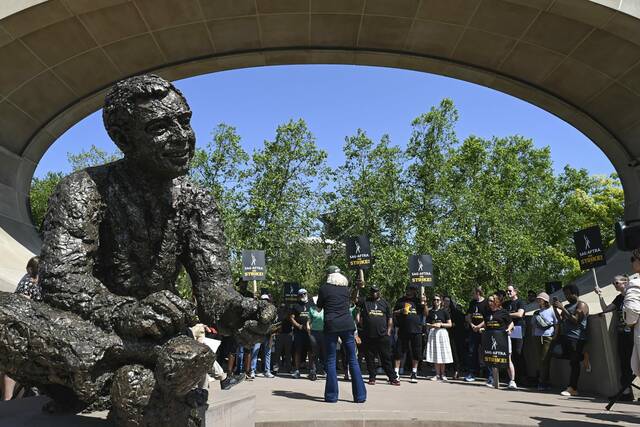https://development.triblive.com/aande/movies-tv/saf-aftra-members-rally-in-pittsburgh-as-hollywood-strike-drags-on/
SAG-AFTRA members rally in Pittsburgh as Hollywood strike drags on

Randy Kovitz is a middle-class actor.
It’s a title he says he’s proud of, with a resume showing credits from film, television and commercials.
His first role was in George Romero’s cult classic and genre-defining movie “Dawn of the Dead,” a cult classic, filmed at Monroeville Mall. He received $50 for a night’s work but said he never saw another dime. A later Romero film, “Knightriders,” was a union gig. He was able to join the Screen Actors Guild, where he got compensation like health benefits and a pension credit.
“I have residuals going back to ‘Hill Street Blues’ and the soap operas I did in the ‘80s. Some checks are for a decent amount of money,” said Kovitz, who graduated from Carnegie Mellon University’s School of Drama. “Some are as low as a penny. I have received some that were zero.”
Speaking Monday at a rally on the North Shore, joined by members of the Screen Actors Guild-American Federation of Television and Radio Artists, Kovitz said the ongoing strike is meant to draw attention to this inequity and other issues in an industry where it’s all too common for performers and crew to work multiple jobs outside of Hollywood to pay their bills. They also say they are facing the threat of artificial intelligence replacing many workers without consent or compensation. In those cases, an actor’s likeness can be reproduced and used in different performances, whether or not it’s something they agree to.
SAG-AFTRA in July joined members of the Writers Guild of America in their strike against the Alliance of Motion Picture and Television Producers, which represents Hollywood’s major studios.
It’s the first strike for actors from film and television shows since 1980. And it’s the first time two major Hollywood unions have been on strike at the same time since 1960, when Ronald Reagan was the actors guild president.
The unions and studios remain at an impasse over several issues — regulation over artificial intelligence, transparency over streaming numbers, and improved residual compensation.
“Almost 90% of the over 160,000 members of our union don’t make enough each year to qualify for health insurance. That amount is $26,470. The poverty level wage for a family of four in the United States is $30,000,” Kovitz said. “We work for studios and streamers headed by people who make tens of millions of dollars a year using our work and the work of our colleagues to tell the stories that the world wants to see on screens large and small.
“And when we work, so do countless others, drivers, hotel workers, dry cleaners, airline employees, suppliers of materials to build sets, it goes on and on.”
Amy Landis, an actor who has appeared on stage and in film, recalled last month when a producer aligned with the AMPTP told Deadline that the studios’ “endgame is to allow things to drag on until union members start losing their apartments and losing their houses.”
“When the CEOs of top studios … say they hope our writers lose their houses or say what the actors are doing by striking is dangerous, I have to ask them, ‘Is this what you really think of us? The people you rely on to create your content?’ Shame on you,” said Landis, who is a resident teaching artist Pittsburgh Public Theater and has served on the faculty of the Carnegie Mellon School of Music as well as the School of Drama.
“We’re not asking for a salary like the one Tom Cruise receives. Tom Cruise is getting his worth. Why are we not being paid a proportional amount? We’re not asking for millions.
“Should fame be the only road to an equal share of compensation? No. This is the narrative we’ve been forced to accept to keep us down. Keep us small, keep us replaceable. Keep us desperate. And make us believe we’re just lucky to be there on that set.”
Landis read off a list of the many films and TV shows that have been filmed in the region, employing local performers and crew that included “The Dark Knight Rises,” “Mindhunter,” “The Outsiders,” “Silence of the Lambs” and “A Man Called Otto.”
“When they come here to Pittsburgh to create content, they want the top local talent, and that is what they get,” Landis said. “We are well known here in Pittsburgh in the industry as a town with high talent.”
The Pittsburgh Film Office says since its inception in 1990, it has assisted more than 200 feature films and television productions to Southwestern Pennsylvania that have generated nearly $2 billion dollars in the region.
Copyright ©2026— Trib Total Media, LLC (TribLIVE.com)
